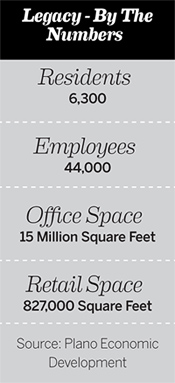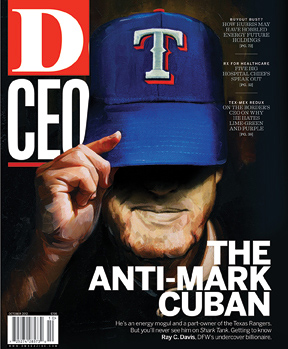When it comes to commercial real estate, there’s no such thing as a sure thing—with the possible exception, North Texas developers say, of Legacy business park. The sprawling corporate campus in Plano is suddenly seeing a burst of build-to-suit and speculative projects—and demand isn’t letting up.
Encana Oil & Gas just took occupancy of its new 13-story office tower, MedAssets has a $28 million campus under construction, Ericsson is adding a 280,000-square-foot office building, Tyler Technologies has a 142,000-square-foot adaptive reuse in the works, Capital One is adding 400,000 square feet, and Denbury Resources, after a series of expansions, has increased its Legacy footprint to more than 500,000 square feet. On the speculative front, Heady Investments and Trammell Crow Co., which now owns most of the developable land in Legacy, are both moving forward with projects—preleasing be damned.
The legend of Legacy is well known. In the early 1980s, EDS founder Ross Perot bought nearly 2,700 acres off what’s now the Dallas North Tollway, with the goal of creating a corporate park for his company and others. Frito-Lay joined the party in 1985 with a 556,000-square-foot facility on 300 acres; two years later, J.C. Penney snapped up 429 acres and announced it would relocate its headquarters to Legacy from New York. The national retailer opened its 1.9 million-square-foot office in 1992. Through the years, big-name brands like Dr Pepper Snapple Group, PepsiCo, and Pizza Hut followed suit.
Sally Bane, executive director of economic development for the City of Plano, has been involved with Legacy since the mid-1990s.
“The vision that Ross Perot had for that parcel of land, and what he has since put into place, has made this portion of North Texas the enormous corporate muscle that it is,” she says.
More than 50,000 people now live or work in Legacy. It’s home to 15 million square feet of office space and more than 827,000 square feet of retail space. Bane cites three primary lures: access to major roadways and Dallas/Fort Worth International Airport via both State Highway 190 and the recently expanded State Highway 121; robust, concrete-encased infrastructure; and proximity to an educated work force.
The park has consistently performed well, even during the recession, Bane says. “We have not experienced a lot of softness in demand; part of that is because of our strong corporate roster” she says.
If you look across North Texas, you won’t see speculative office development of much scale—except in Legacy. Randy Heady is among those betting on the park. It’s an educated guess. His Heady Investments has been active on the outskirts of Legacy since 1996, developing five office buildings totaling 1 million square feet—all achieving full occupancy.
He’s now working on a six-story, 164,000-square-foot project on the southeast corner of the tollway and Headquarters Drive. A 185,000-square-foot second phase is planned for the northeast corner of the intersection.
“There have been no cranes in the air for five years—the first time this has happened in the 41 years I’ve been in the business,” he says. “As a result of the vastly expanding tenant base in the Tollway/West Plano area, we see rents moving up substantially next year in Class A buildings, where there has been the most demand and least volume of new construction.”
Although the corporate headquarters base in Legacy is impressive, Heady says, “it’s the Town Center and its synergy that sets it apart from other Class A office parks in the southern part of the United States. The mantra of Fortune 500 companies today is live-work-play. Legacy Town Center fulfills that; it’s a major company’s CEO’s dream.”

“I’d go have lunch at Park and Preston, and all of EDS was down there,” she says. “You’d see the company stickers on their cars. It was crazy.”
Kasko discussed the challenge with Art Lomenick, a former exec with Post Properties. He told her about an emerging “live-work-play” concept called “New Urbanism,” and put her in touch with one of its pioneers, Andres Duany. After several years of research and a Duany-led charrette in Plano, plans for Legacy Town Center were born in the late 1990s. RTKL did the masterplan, Lincoln Property Co.
handled office development, and Fehmi Karahan was selected to oversee The Shops at Legacy.
“It was the exact opposite of what had been intended for Legacy,” Kasko says of the town center. “Legacy was built with large setbacks—big expanses of landscaped grounds, no sidewalks, very car-friendly. We were talking about people-friendly, walking spaces, and things right up close to the curbs. It broke all of Legacy’s rules.”
Today, the dense mixture of hotels, residences, restaurants, and shops is one of the most successful examples of New Urbanism in the country.
Kasko left EDS for an executive post with Abbott Laboratories in Chicago in 2003, but today, nearly 10 years later, she remains fiercely protective of Legacy Town Center—and adamant that credit for its success be shared with the many people who worked on it.
“It takes a village to build a town center,” she says.
Big Development Projects
Ask Adam Saphier about Legacy business park, and the regional president of Trammell Crow breaks into a wide grin. And why shouldn’t he smile? Trammell Crow has three major projects under way in Legacy—the Ericsson expansion, MedAssets’ build-to-suit, and Legacy Towers, its spec project.
What’s more, with the exception of excess land held by Frito-Lay and J.C. Penney, Trammell Crow owns most of the remaining developable property within the park. It had initially acquired about 400 acres from EDS five years ago. After developing One Legacy Circle and corporate projects for Pizza Hut and Capital One, it has about 90 acres left.
Legacy Towers consists of a 13-story, 341,000-square-foot first phase, and a seven-story, 192,000-square-foot second phase, at the Dallas
North Tollway and Legacy Drive—the “front door” to Legacy, Saphier says.
“We’re moving forward,” he says. “Our philosophy is to buy the very best sites in the very best submarkets and, when the real estate fundamentals justify it, go spec.”
KDC has been a big player in Legacy as well. The Dallas-based company has built or redeveloped nearly 3 million square feet in the park, starting with Countrywide in 1994 and followed by projects for PepsiCo, Intuit, AT&T, St. Jude Medical, Denbury Resources, and Rent-a-Center. It recently wrapped up work on Encana, and is under way with Tyler Technologies’ redevelopment of a former YMCA facility.
Perhaps its biggest success in the park, though, is The Campus at Legacy. KDC acquired the three-building, 1.1 million-square-foot complex from EDS in 2005, as part of a larger portfolio buy. Other than some short-term leases in effect, the buildings were essentially vacant. KDC transformed the complex—and filled it up. The largest tenant is Denbury Resources, which occupies 510,000 square feet.
In August, KDC sold one of the three buildings to a partnership between Transwestern and State Farm Life Insurance Co.
“Legacy right now continues to be on fire,” says John Brownlee, senior vice president of KDC. “Access to the airport and The Shops at Legacy and other amenities there gives it an edge. Companies are choosing to be in that location; they feel employee density is there.”
The fact that Legacy is no longer in the hands of a single overseer presents some challenges, as the park continues to mature and evolve, Kasko says.
“I think it’s time to look at Legacy and say, ‘What’s next? How do we get to the next level, without losing its charm and warmth, and how do you manage that change?’ You can’t just let it happen,” she says. “You have to have a plan.”






